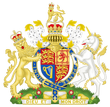| Provinz von Großbritannien (de) | |||||
|---|---|---|---|---|---|
| Province of Great Britain (en) | |||||
| Province of the Duchy of Brunswick | |||||
| |||||
| Capital | London | ||||
| Official language Regional languages |
German (de facto), English Irish, Ulster Scots, Scottish Gaelic, Scots, Welsh, Cornish |
||||
| Demonym | British, Briton | ||||
| Government Type - Monarch - Statthalter |
Constitutional Monarchy Princess Victoria Gottlieb Heisel |
||||
| Total Area | 84,600 sq. mi. | ||||
| Time Zone | WET | ||||
The Province of Great Britain (German: Provinz von Großbritannien) is a province of the Duchy of Brunswick. The province is made up of the former United Kingdom. It is bordered by the Atlantic Ocean, the North Sea, the English Channel, and the Irish Sea. Its capital is London.
History[]
Great Britain was inhabited by the Celts and other tribal people before the invasion of the Romans in the 1st century B.C. The Roman legions withdrew by the 5th century A.D. and left the way open for the Angles, Saxons, and Jutes to invade. The Welsh and Scottish were not as affected by the invasions but the Britons were forced to flee into Wales and Scotland.
The Kings of Wessex untied the country in the 10th century and a dispute over the succession arose after the death of Edward the Confessor. The Duke of Normandy invaded England to defeat the Saxon king Harold II at the Battle of Hastings. The Normans were victorious and introduced Norman French law and feudalism. Royal power grew during the reign of Henry II and culminated in King John being forced to sign the Magna Carta. Edward I conquered Ireland and subjected Wales, but made little progress in Scotland. The English were ousted from Scotland in 1314 after the Battle of Bannockburn.
The House of Commons was developed in the late 13th and early 14th century with powers to raise taxes. The Hundred Years’ War caused England to lose most of their territory in France because of Edward III’s claim to the French throne. The Black Death reduced the population by one-third. The Houses of York and of Lancaster struggled for the throne during the Wars of the Roses. Henry VII was victorious after the Battle at Bosworth Field.
Henry VIII established a separate church after he could not obtain a divorce from Catherine of Aragon from the Roman Catholic Church. This caused religious turbulence during his reign, the reign of Edward VI, and the reign of Mary I. Henry VIII’s daughter, Elizabeth I, set up the Church of England during her reign. Elizabeth I faced and defeated the Spanish Armada in 1588. Elizabeth I made England an international power during her reign. After the death of Elizabeth I, the Stuarts gained control of England and united Great Britain with James VI of Scotland’s accession to the throne as James I. Charles I went to war with some of parliament in 1642, which led to his defeat and execution in 1649. The monarchy was abolished and Oliver Cromwell came to power. Cromwell died in 1658 and Charles II was restored to the throne in 1660. Charles II was succeeded by James II, who was dethroned during the Revolution of 1688. The throne passed to Mary II, who co-ruled with William of Orange. Queen Anne joined England and Scotland with the Act of Union of 1707. The electors of Hanover were asked to become the ruling family of England.
The British Empire continued to expand through constant wars with France, which gave them gains in North America and India. The growth was checked by the American Revolution. Great Britain continued their conflict with France from 1793 and until the end of Napoleonic Wars in 1815. The growth of democracy in the government occurred during the reign of Queen Victoria.
Britain entered World War I after the German invasion of Belgium. Britain entered World War II after the German invasion of Poland.
Great Britain became a part of the Duchy in 2010.


